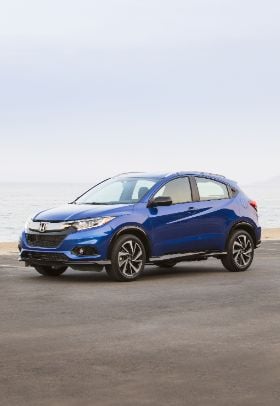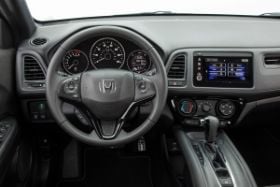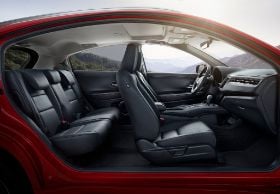2020 Honda HR-V
Performance • Comparisons
What's New for 2020?
The current (and first) generation of HR-Vs was introduced back in 2016. Since then, a few tweaks have been made, but there have been no significant changes. And that holds true for the 2020 Honda HR-V line-up. You might find one or two very minor changes if you spend time digging for them, but everything from 2019 essentially carries over on the 2020 models.
The Pros and Cons of the 2020 Honda HR-V
The Pros:
✅ A Spacious Cabin
One of the things that small crossover SUVs often struggle to get right is cabin space. The 2020 Honda HR-V does not have that problem in the slightest. Thanks to Honda's innovative design, the HR-V's interior is actually quite spacious. Whether you are sitting up front in the cockpit or riding passenger in one of the rear seats, you will feel as though you have plenty of space. Hips, knees, shoulders, and heads can all comfortably fit inside of this vehicle. With how much ajustability you get on the front seats, you can bet there is plenty of room up there. The rear can even fit three average-sized adults without any hassle.
✅ A Highly Versatile Cargo Design
Honda has gone all-out on making their vehicles as utilitarian as possible. While you will find plenty of space and spaciously-designed small item storage spaces smartly placed throughout the cabin, the cargo area also gets its own clever crafting. With all seats left in place, the HR-V has 23.2 cubic feet of cargo space, which is almost the biggest in its class. Fold the rear seats down and you get a maximized 55.9 cubic feet, leaving you plenty of room to store your groceries or sporting items. Plus, you get a lot of neat little storage areas and tools to help you keep everything organized in the cargo area.
✅ Superb Outward Visibility
Outward visibility from the cockpit of the 2020 Honda HR-V is expansive. The driver's seat can be power-adjusted a number of different ways, and the tilt and telescoping steering wheel gives you even more leeway to maneuver yourself into the best possible driving position. The dashboard sits pretty low, and the windshield is nice and wide. The slender, well-spaced roof pillars lend a lot to the vast view your get while sitting in the driver's seat. The view out the rear is also clear since the headrests do not get in the way and the rear window is considerably large. Even the blind spots are small, but you can get the blind spot monitoring system to help, and there is a standard rear-view camera equipped.
✅ An Excellent Fuel Economy
Want a vehicle that will save on fuel? The 2020 Honda HR-V is much more fuel efficient than a full-sized SUV. It gets about 28 mpg combined (with 26 mpg in the city and 31 mpg on the highway), which is definitely an above-average showing for a subcompact SUV with all-wheel drive equipped. While you obviously do not get as much as you would on an Accord, the HR-V will still save you a lot of money at the pump.
The Cons:
❌ It is Slow to Accelerate
One of the most noteworthy downsides to driving the 2020 Honda HR-V is its super sluggish acceleration. Sure, vehicles in this class are not exactly known for their bursts of speed, but the HR-V's acceleration ability is painful. This vehicle needs about 10.4 seconds to get from 0 to 60 mph, which is one of the most drawn-out times in not just this segment, but for many. It is so disappointing due to the 1.8-L engine's inability to handle anything that is not solidly flat ground. You cannot put the pedal to the metal and expect to pass anyone in this vehicle, much less efficiently merge onto the highway. This is indeed quite a sore spot in Honda's entire fleet of vehicles.
❌ Excessive Engine Noise
So, not only is the engine sluggish as can be, but it puts up a huge fuss! Hondas normally have pretty quiet engines, but the HR-V's 1.8-L is grumbly. You will hear a constant whine coming from it even when just scuttling about town. Should you decide to floor it for some reason (and good luck trying to do that), this engine will howl and moan. It is massively under-powered and does not like to be pushed. The noise can definitely be heard inside the cabin, which will overpower your music or conversations with rear seat passengers.
View more pros and cons of the 2020 HR-V ›
Configurations / Trim Levels
Now that you are aware of a few of the pros and cons to owning and driving the 2020 Honda HR-V, we need to break down its trim levels. Knowing what to expect is crucial when you are looking at new cars, so be aware that the HR-V's trim levels equip different and upgraded features the higher up you go. And, of course, they do get more expensive as you climb the trim level ladder.
There are five different trim levels on the 2020 Honda HR-V: the base LX, Sport, EX, EX-L, and Touring. All of them are powered by the problematic 1.8-L engine, which only gets 141 hp and 127 lb-ft of torque, which is not a lot for a vehicle in this class. This engine is paired up with a standard continuously variable automatic transmission (CVT). If you want all-wheel drive, it is available for each trim level and is definitely handy for those who live in places where inclement weather often causes driving to become a bit hazardous. Also, take note that there are no optional packages available, so this should help to make the buying process a bit easier.
The base LX trim level is surprisingly well-equipped with standard infotainment and safety features. Although it does not have Honda Sensing technology, you do get an array of standard safety tech, ranging from the multi-angle rear-view camera to brake assist and a tire pressure monitoring system. There is a 160-watt 4-speaker sound system, a 5-inch color LCD screen, Bluetooth connectivity, and one USB audio port up front. Creature comforts include cruise control, an air conditioning system, one-touch turn indicators, map lights, LED pocket lights, 12-volt power outlets for the front and back rows...
For a detailed comparison of these trim levels, see our recent research into the 2020 Honda HR-V Trim Level Comparisons and Configurations. ›
Driving Impressions and Performance
Unfortunately, the 2020 Honda HR-V does not get high marks for its driving performance. If anything, it gets marked down below the average for this segment. The standard 1.8-L engine is far too under-powered to make the performance of the HR-V that exciting. Its acceleration is painstakingly slow, and you can tell that it is not putting out enough power to get the HR-V up and moving. Getting from 0 to 60 mph in 10.4 seconds is just an awful showing for this segment.

Luckily, handling and steering are pretty solid. You will find you get enough feedback coming to you through the steering wheel, and you will always know exactly how the wheels are tracking on the road surface. The steering system is well-weighted, and the steering wheel can easily be adjusted to where it feels most comfortable for you. There is a suspension that feels well-tuned, and you will never notice any amount of body roll in this subcompact SUV.
The engine noise is highly unattractive though. If you want a quiet runner, then the HR-V is not the vehicle for you. It spats and hisses when you push the pedal down hard, and even when you are just driving around town, you will hear the engine grumbling. You will also feel some vibrations coming into the cabin from the engine, something which certainly will take away from the overall quality of the ride. This is such a bummer since Honda has plenty of other vehicles out right now that do not have this problem at all.
In other words, there are some elements of the driving performance that leave something to be desired. The engine is the big problem here. Something with more power would be better tailored to a vehicle like the HR-V. While that would bring the fuel economy down, it would improve how the vehicle operates in day to day situations. As of right now, though, the HR-V's stellar handling and steering are being outshone by this monstrosity of a small engine. Owners and mechanics alike will probably agree that this engine needs to go, so here is hoping that Honda listens to its consumers about this engine.
Safety
Safety features are fairly abundant if you get the EX trim level or above. Those trims come equipped with the Honda Sensing suite. This suite bundles a bunch of driver aids, ranging from forward collision mitigation to lane departure warning. They are all known to work pretty well, although even when you put it on the closest follow setting, adaptive cruise control will still keep your vehicle at an overly extenuated distance from the auto in front of you. It is a bit annoying, but it really is a minor inconvenience. Still, if you want the utmost in safety features, the Honda Sensing suite has everything you need.

But what about actual safety ratings? Just how well might the HR-V endure a crash? Is there anything on it that is not up to par? The Insurance Institute of Highway Safety (better known as the IIHS) gave the 2020 Honda HR-V an all-around "Good" rating on the Crashworthiness tests it conducts. The HR-V did lose points for its headlights on all trim levels, and the LATCH child car safety system was rated as "Acceptable" when it came to its ease of use. The 2019 HR-V was listed as a Top Safety Pick, and the 2020 will likely get this title from IIHS as well.
The National Highway Traffic and Safety Administration (NHTSA) also assessed the 2020 Honda HR-V and assigned it an overall rating of five (out of five) stars. The Overall Front crash test resulted in four stars, with the front driver and passenger sides each receiving four out of five stars on the test. Side crash tests all resulted in five out of five stars, and the rollover test assessed observed a 13.50% risk (which is an average rate for this segment) and no observable tip. NHTSA recommends getting the forward collision mitigation and lane departure features that are included with the Honda Sensing suite.
Interior

Outward visibility is excellent from your seat in the cockpit. Look fore, aft, and to each side, and you will have a really clear view of what is around you. The slender front roof pillars and wide windshield let you see right down the hood to the nose of the HR-V. You will not find too many situations in which you will scrape the front end on a curb. Blind spots are also relatively small. The standard rear-view camera will help out if you are stuck backing out of a tight parking spot, but you will not likely rely on it too much since the rear view with the naked eye is excellent.
The controls are a bit of a mixed bag. If you were to take away the wonky touchscreen and replace it with a more appropriately responsive one, the control set-up would spell perfection. The controls are all well-marked, easy to figure out, and placed within the driver's reach. Having this many physical controls is definitely a nice thing. But the touchscreen is troublesome and hard to get past. You will find yourself looking at the screen too much, for too lengthy of times, while driving and trying to operate it. You might have to touch the screen several times just to get one button to work, which is not something you should have happen while driving. Other Hondas are getting improved infotainment systems, but the HR-V is not quite there yet.
Exterior Color Options








Reliability
People love Hondas and keep coming back for more. There is this sense of security and reliability that you get once you have owned a Honda. Even if you have driven around a beaten-up 25-year-old Accord, you know that you have had a solid vehicle. And the HR-V seems to be upholding that tradition.
The 2020 Honda HR-V might not be the most powerful vehicle, but people are digging it. Since the HR-V has only been around since 2016, we cannot look back at decades' worth of reviews and scores. But we can look at what people are saying about the HR-Vs that they have bought since the HR-V leaped onto the scene.
Comfort is really the name of the game here, and people absolutely adore the magic seats. You get a lot of comfort mixed with a ton of utility. Need more cargo space? Move the seats around! It is quite simple, and buyers are delighted that they are driving something so innovative. Owners with dogs really like how simple the set-up is to switch around so that they can quickly get their beloved pooches in and out of the vehicle without much hassle.
Some drivers find that the acceleration is not as slow as others claim or simply just do not mind the acceleration not being super-duper speedy. Not everyone wants to zoom. A lot of former CR-V buyers have made the switch to the HR-V since they are impressed with the fuel economy it offers and do not mind a slower acceleration. But the CR-V is still a strong contender against her little sister.
Time will tell just how well the 2020 Honda HR-V holds up. But, as of right now, things are looking pretty promising. Honda knows what they are doing and typically build vehicles to endure a lot of usage.
How Does It Compare
2020 Honda HR-V vs 2020 Subaru Crosstrek
One of the 2020 Honda HR-V's toughest competitors is the 2020 Subaru Crosstrek. All-wheel drive comes standard on the Crosstrek, which has a stating MSRP of just about $1,000 over that of the HR-V. It has a superbly high ground clearance that makes the Crosstrek great for taking off of the beaten path. Also, for being a hatchback, the Crosstrek has remarkably spacious rear seats, drawing a close parallel to the HR-V. In addition to all of that, the Crosstrek has a cozy ride quality and provides excellent outward visibility for the driver.
The Crosstrek has a few downfalls that are reminiscent of what you will find n the HR-V. The Crosstrek takes its time accelerating when you want to get it up to speed on the highway. Its handling is less refined than that on the HR-V, and its cargo space feels small and inefficient by comparison.
See our In-Depth Comparison of the 2020 HR-V and the Crosstrek Here
2020 Honda HR-V vs 2020 Hyundai Kona
The 2020 Hyundai Kona is a competitively priced vehicle that is powered by a stronger 2.0-L engine and 6-speed automatic transmission. If you want superb acceleration, there is a turbocharged engine that you can opt for, and a lot of buyers are digging the extra power it generates. It also handles extremely well and tends to make the driving experience a pleasant one overall. And, for the money, you get a ton of standard features packed into even the base trim level.
Of course, like all other vehicles, the 2020 Hyundai Kona is not perfect. Its base engine honestly is nothing to write home about, and the transmission that comes with the turbo engine has some incredibly noticeable gear shifts. To top that off, the interior is littered with hard plastic surfaces, which immediately reeks of "economy vehicle", even though it definitely is not one.
On the plus side, if you are looking for an electric version of a small crossover, the Kona does have an EV variant available. It has just about the same strengths and pitfalls as the gasoline-powered version.
See our In-Depth Comparison of the 2020 HR-V and the Kona Here
2020 Honda HR-V vs 2020 Toyota C-HR
The 2020 Honda HR-V gets stiff competition from the 2020 Toyota C-HR, which has a unique exterior style that really sets it apart from the rest of the group. It is also loaded with a lot of standard features and has some sporty handling capabilities.
But the C-HR is problematic in a few significant ways. For starters, the C-HR does not give you an option for equipping all-wheel drive, which many of its rivals do. AWD is nice to have on a vehicle like this, especially if you drive somewhere that often gets slammed by inclement weather conditions. Also, if you think the HR-V is slow to accelerate, then you will find the C-HR to be the sloth of the bunch. Its acceleration lacks any sort of "oomph" and is a bit aggravating.
Also, you will be seriously cramped for space inside of this vehicle. Sure, this segment is not known for being roomy, but the C-HR feels positively minuscule next to the HR-V. And its cargo space? Small and not the most smartly crafted. You will also have to crank your stereo up to hear over the excessive wind and road noise that seep into the vehicle as you take it up to speed. Let us just say that it is not too pleasant to hear.
See our In-Depth Comparison of the 2020 HR-V and the C-HR Here
2020 Honda HR-V vs 2020 Toyota RAV4
The 2020 Toyota RAV4 (which can also be bought with a hybrid powertrain) is a good alternative to the 2020 Honda HR-V if you need to step it up another segment for something bigger. The RAV4 has a quiet, relaxed, and refined ride quality that its occupants up front and in the rear can all enjoy. Bumps get smoothed over with ease, and there is not a lot of outside noise that makes its way into the cabin. Of course, you get a ton of cargo space and a rear seat that gives passengers quite a bit of room to spread themselves out and chill. And the controls? They are smartly laid out in an easy-to-follow fashion with a touchscreen that is not a nightmare to navigate.
Unfortunately, the RAV4 has some pretty obnoxious pitfalls. For starters, the base powertrain is under-powered and makes for some sluggish acceleration, much like what you get on the smaller HR-V. Even more unfortunately, this is the only powertrain available. That's right - you cannot try to opt for anything stronger.
Side note: You will also have to deal with the RAV4's uncomfortable front seats and lackluster steering that gives you absolutely no feedback. All in all, it really is not that enjoyable to drive if you are looking to get a few thrills.
See our In-Depth Comparison of the 2020 HR-V and the RAV4 Here
2020 Honda HR-V vs 2020 Honda Fit
Last, but certainly not least, we have the 2020 Honda Fit. Okay, okay, it might be "least" when it comes to size, but the Fit leaves a pretty good impact on its segment. If you want something smaller than the HR-V, then the Fit might prove to be an attractive alternative. The $17,000 starting MSRP price tag will surely catch your eye, but the Honda Fit also offers a ton of standard infotainment and safety features for the price. You also get a spacious inner design that makes you feel like you are riding inside of a larger vehicle. If you need to maximize the cargo area, you can do so and also take advantage of its innovative design (much like what you will find inside of the 2020 Honda HR-V).
The 2020 Honda Fit is not exactly a high-powered vehicle with its small 1.5-L engine, which is paired with a CVT. However, it is the brakes that are disappointing here, as they come across as being a little too soft for the liking. Also, take note that taller passengers will have trouble fitting their heads into the rear seat of the Fit since the sloping design tends to limit head space back there.
See our In-Depth Comparison of the 2020 HR-V and the Fit Here
• 2020 Honda HR-V vs Honda CR-V
• 2020 Honda HR-V vs Subaru Crosstrek
• 2020 Honda HR-V vs Hyundai Kona
• 2020 Honda HR-V vs Toyota C-HR
• 2020 Honda HR-V vs Toyota RAV4
• 2020 Honda HR-V vs Honda Fit
• 2020 Honda HR-V Prices. MSRP vs Invoice Price vs True Dealer Cost
• 2020 Honda HR-V Trim Levels and Configurations
• 2020 Honda HR-V Pros vs Cons

